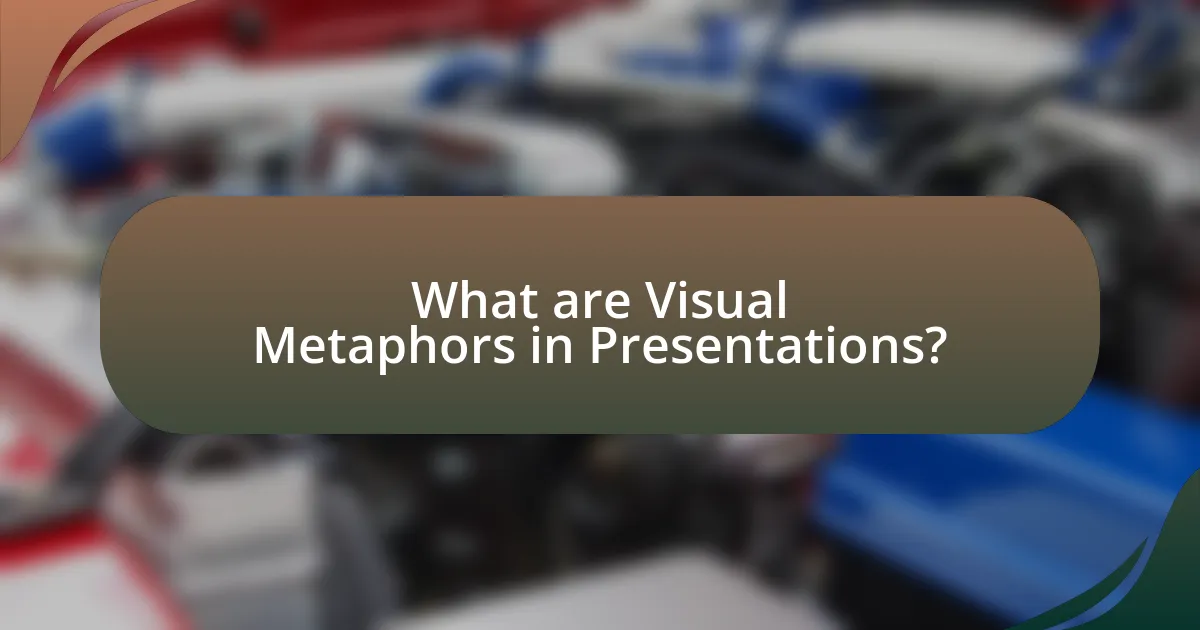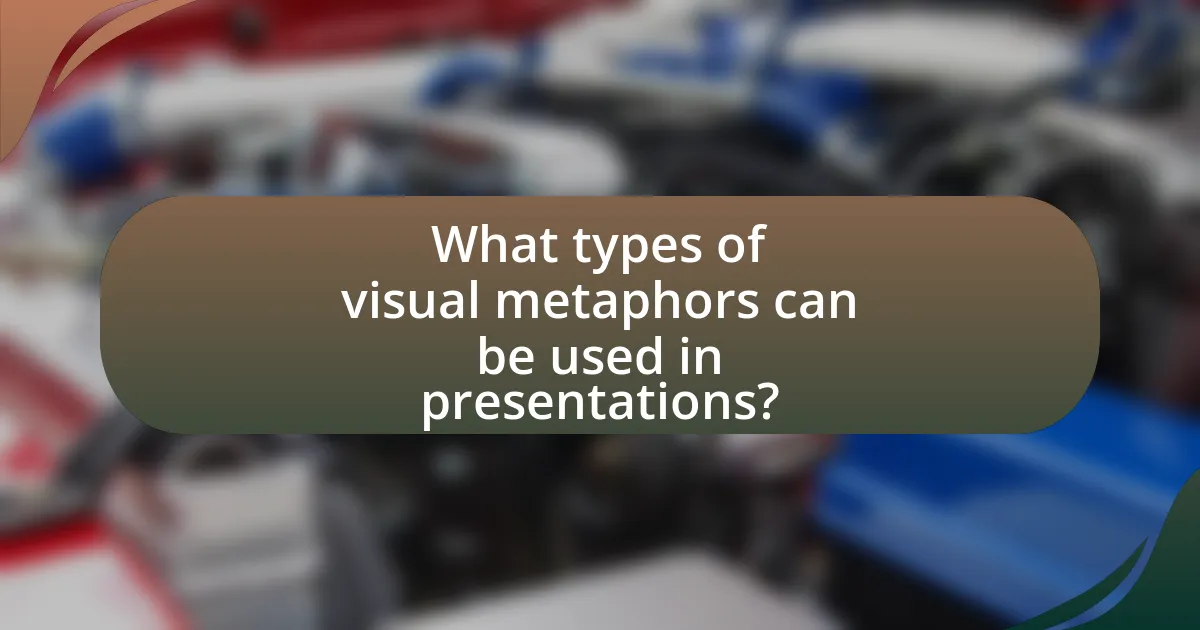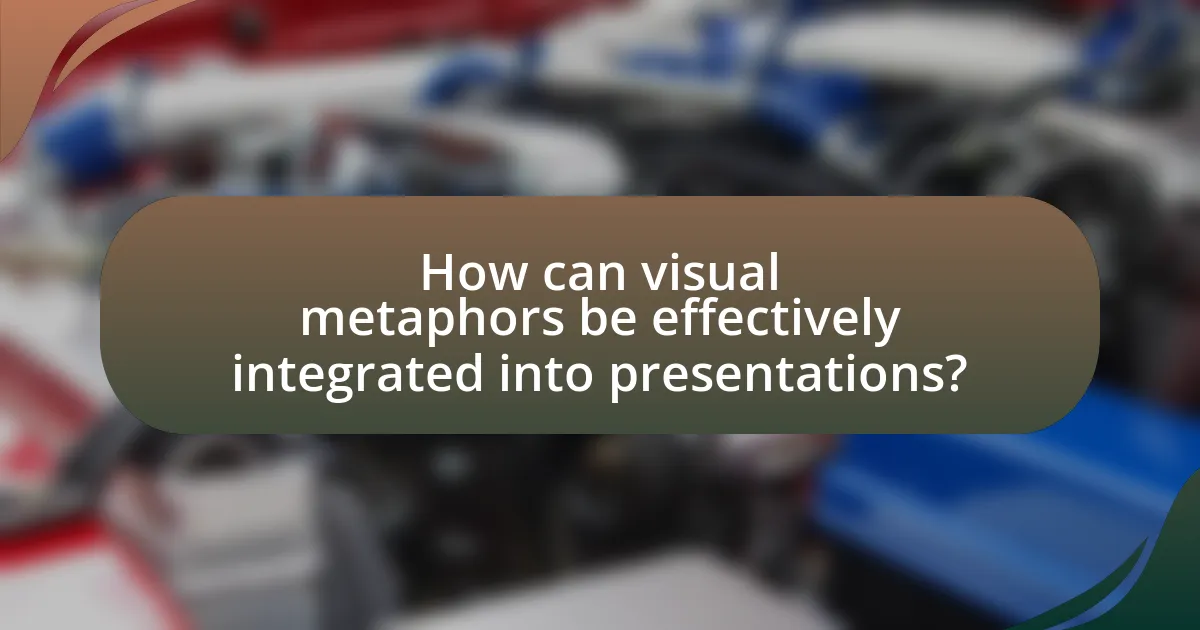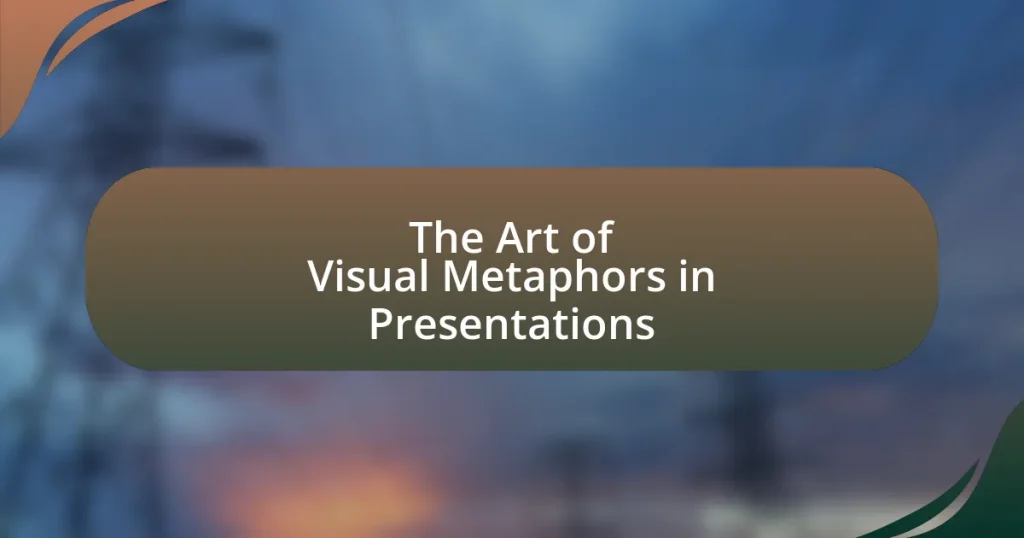The article focuses on the significance of visual metaphors in presentations, defining them as symbolic imagery that conveys complex ideas in a relatable manner. It explores how visual metaphors enhance communication by simplifying abstract concepts, improving audience engagement and retention through cognitive processes. Key psychological principles, such as dual coding theory and cognitive load theory, underpin their effectiveness. The article also discusses best practices for creating and integrating visual metaphors, the importance of clarity and relevance, and common pitfalls to avoid, ultimately highlighting their role in effective presentation design and storytelling.

What are Visual Metaphors in Presentations?
Visual metaphors in presentations are visual representations that convey complex ideas or concepts through symbolic imagery. They enhance understanding by linking familiar images to abstract concepts, making the information more relatable and memorable. For example, using an image of a ladder to represent growth or progress effectively communicates the idea of advancement in a straightforward manner. Research indicates that visual metaphors can significantly improve audience engagement and retention of information, as they tap into cognitive processes that facilitate learning and comprehension.
How do visual metaphors enhance communication in presentations?
Visual metaphors enhance communication in presentations by simplifying complex ideas and making them more relatable to the audience. They create mental images that facilitate understanding, allowing viewers to grasp abstract concepts through familiar visual representations. Research indicates that visuals can improve retention of information; for instance, studies show that people remember 65% of information when paired with relevant images, compared to only 10% when presented with text alone. This effectiveness stems from the brain’s ability to process visuals 60,000 times faster than text, making visual metaphors a powerful tool for engaging and informing audiences.
What psychological principles underlie the effectiveness of visual metaphors?
Visual metaphors are effective due to several psychological principles, including dual coding theory, cognitive load theory, and the principle of similarity. Dual coding theory posits that information is better retained when presented in both verbal and visual formats, as the brain processes images and words simultaneously, enhancing memory retention. Cognitive load theory suggests that visual metaphors can simplify complex information, reducing cognitive overload and making it easier for audiences to understand and remember key concepts. The principle of similarity indicates that visual metaphors create connections between familiar and unfamiliar ideas, facilitating comprehension by linking new information to existing knowledge. These principles collectively demonstrate how visual metaphors enhance communication and understanding in presentations.
How do visual metaphors aid in audience retention of information?
Visual metaphors significantly enhance audience retention of information by creating relatable and memorable connections between complex concepts and familiar imagery. This cognitive association allows individuals to better understand and recall information, as studies indicate that visuals are processed 60,000 times faster than text. Furthermore, research published in the journal “Cognitive Science” by researchers such as Mayer and Moreno demonstrates that the use of visual metaphors can lead to improved learning outcomes, as they facilitate deeper cognitive processing and engagement. Thus, visual metaphors serve as effective tools in presentations, making information more accessible and memorable for audiences.
Why are visual metaphors important in presentation design?
Visual metaphors are important in presentation design because they enhance understanding and retention of complex ideas. By using familiar imagery to represent abstract concepts, presenters can create cognitive connections that facilitate comprehension. Research indicates that visuals can improve information retention by up to 65%, as they engage both verbal and visual processing pathways in the brain. This dual engagement helps audiences grasp and remember key messages more effectively, making visual metaphors a powerful tool in effective communication.
What role do visual metaphors play in storytelling during presentations?
Visual metaphors enhance storytelling during presentations by simplifying complex ideas and making them more relatable to the audience. They serve as cognitive shortcuts, allowing viewers to grasp abstract concepts through familiar imagery. Research indicates that visual metaphors can increase retention and understanding; for instance, a study published in the journal “Cognitive Science” by researchers at the University of California found that participants who viewed presentations with visual metaphors recalled information 30% better than those who did not. This effectiveness stems from the brain’s ability to process visual information more efficiently than text, thereby facilitating deeper emotional connections and engagement with the content.
How can visual metaphors simplify complex ideas for the audience?
Visual metaphors simplify complex ideas for the audience by creating relatable imagery that conveys abstract concepts in a more understandable manner. By using familiar visuals, such as comparing a business strategy to a roadmap, audiences can grasp intricate ideas quickly and intuitively. Research indicates that visual information is processed 60,000 times faster than text, which underscores the effectiveness of visual metaphors in enhancing comprehension and retention of complex information.

What types of visual metaphors can be used in presentations?
Visual metaphors in presentations can include analogies, symbols, and imagery that represent concepts or ideas. For instance, using a bridge to symbolize connection or transition effectively conveys the idea of linking two points. Additionally, a light bulb can represent innovation or new ideas, while a mountain can symbolize challenges or goals. These visual metaphors enhance understanding by providing relatable imagery that resonates with the audience, making complex ideas more accessible. Research indicates that visual metaphors improve retention and comprehension, as they engage both cognitive and emotional responses, thereby reinforcing the message being communicated.
How can literal and abstract metaphors be differentiated in presentations?
Literal metaphors in presentations refer to direct comparisons that use concrete imagery, while abstract metaphors involve more conceptual or symbolic representations. For example, saying “time is a thief” is an abstract metaphor, as it conveys a concept without a physical representation, whereas “the sun is a warm blanket” is a literal metaphor, as it uses tangible imagery to evoke warmth. This differentiation is crucial for effective communication, as it helps the audience grasp complex ideas through relatable visuals or understand deeper meanings through symbolic language.
What are examples of literal visual metaphors in presentations?
Examples of literal visual metaphors in presentations include using a light bulb to represent ideas or innovation, a ladder to symbolize growth or progress, and a puzzle piece to illustrate problem-solving or teamwork. These visual metaphors effectively convey complex concepts in a straightforward manner, enhancing audience understanding. For instance, the light bulb metaphor is widely recognized as a symbol of creativity and insight, making it an effective choice in presentations focused on brainstorming or innovation.
What are examples of abstract visual metaphors in presentations?
Abstract visual metaphors in presentations include concepts such as a light bulb representing ideas or innovation, a maze symbolizing complex problem-solving, and a bridge illustrating connection or transition. These metaphors effectively convey complex ideas through simple imagery, enhancing audience understanding. For instance, the light bulb metaphor is widely recognized in business contexts to signify creativity and breakthrough thinking, while the maze metaphor can visually represent the challenges faced in strategic planning. Such metaphors are powerful tools in presentations, as they facilitate cognitive processing and retention of information by linking abstract concepts to familiar visuals.
What are the best practices for creating effective visual metaphors?
Effective visual metaphors should be clear, relevant, and relatable to the audience. Clarity ensures that the metaphor is easily understood, while relevance connects the metaphor to the core message being conveyed. Relatability allows the audience to engage with the metaphor on a personal level, enhancing comprehension and retention. Research indicates that visual metaphors can improve memory recall by up to 65% when they resonate with the audience’s experiences (Mayer, 2009, “Multimedia Learning”). Therefore, selecting metaphors that align with the audience’s cultural context and prior knowledge is crucial for effectiveness.
How can one ensure clarity and relevance in visual metaphors?
To ensure clarity and relevance in visual metaphors, one must align the metaphor with the audience’s understanding and the presentation’s core message. This involves selecting imagery that directly relates to the subject matter and resonates with the audience’s experiences or knowledge. For instance, using a light bulb to represent ideas is effective because it is widely recognized as a symbol of innovation and insight. Additionally, maintaining simplicity in design enhances clarity; complex visuals can confuse rather than clarify. Research indicates that visuals that are easily interpretable lead to better retention of information, as supported by studies on cognitive load theory, which emphasize that simpler visuals reduce cognitive overload and improve comprehension.
What design elements should be considered when incorporating visual metaphors?
When incorporating visual metaphors, key design elements include clarity, relevance, color, composition, and context. Clarity ensures that the metaphor is easily understood by the audience, while relevance connects the metaphor to the core message of the presentation. Color plays a crucial role in evoking emotions and reinforcing the metaphor’s meaning, as different colors can convey various feelings and associations. Composition involves the arrangement of visual elements to guide the viewer’s eye and enhance the metaphor’s impact. Lastly, context is vital; the metaphor should align with the overall theme and purpose of the presentation to resonate effectively with the audience.

How can visual metaphors be effectively integrated into presentations?
Visual metaphors can be effectively integrated into presentations by aligning them with the core message to enhance understanding and retention. When visual metaphors are relevant to the subject matter, they create a cognitive bridge that helps the audience grasp complex ideas more easily. Research indicates that visuals can improve information retention by up to 65% compared to text alone, as demonstrated in studies by Richard Mayer, which highlight the dual coding theory where visual and verbal information are processed simultaneously. By strategically placing visual metaphors at key points in the presentation, presenters can reinforce their narrative and engage the audience more deeply, making the overall communication more impactful.
What strategies can presenters use to introduce visual metaphors?
Presenters can introduce visual metaphors by using relatable imagery that connects with the audience’s experiences. This strategy enhances understanding and retention by linking complex ideas to familiar concepts. For example, a presenter might use an image of a bridge to symbolize connection, effectively illustrating the concept of collaboration. Research indicates that visual metaphors can improve audience engagement and comprehension, as they activate both cognitive and emotional responses, making the content more memorable.
How can presenters gauge audience understanding of visual metaphors?
Presenters can gauge audience understanding of visual metaphors through interactive techniques such as audience polling, feedback sessions, and observational cues. Polling allows presenters to ask specific questions about the visual metaphors used, enabling them to assess comprehension in real-time. Feedback sessions, where audience members share their interpretations, provide qualitative insights into their understanding. Additionally, presenters can observe non-verbal cues, such as facial expressions and body language, to determine if the audience is engaged and grasping the intended message. Research indicates that active engagement strategies significantly enhance audience retention and understanding of complex concepts, including visual metaphors.
What techniques can enhance the impact of visual metaphors during a presentation?
Techniques that can enhance the impact of visual metaphors during a presentation include using high-quality images, ensuring relevance to the topic, and integrating storytelling elements. High-quality images capture attention and evoke emotions, making the metaphor more memorable. Relevance ensures that the metaphor aligns with the audience’s understanding and the presentation’s message, thereby increasing comprehension. Integrating storytelling elements creates a narrative that engages the audience, making the metaphor resonate on a deeper level. Research indicates that visuals can improve retention by up to 65%, highlighting the effectiveness of these techniques in enhancing audience engagement and understanding.
What common pitfalls should be avoided when using visual metaphors?
Common pitfalls to avoid when using visual metaphors include overcomplicating the imagery, which can confuse the audience, and using metaphors that lack relevance to the core message, leading to misinterpretation. Additionally, relying on clichés can diminish the impact of the metaphor, making it less memorable. Research indicates that clarity and relevance are crucial for effective communication; for instance, a study by Richard E. Mayer in “The Cambridge Handbook of Multimedia Learning” emphasizes that visuals should enhance understanding rather than detract from it.
How can overcomplicating visual metaphors detract from the message?
Overcomplicating visual metaphors can detract from the message by obscuring the intended meaning and confusing the audience. When visual metaphors become too intricate, they can lead to misinterpretation, as viewers may struggle to connect the metaphor to the core message. Research indicates that simplicity in visual communication enhances comprehension; for instance, studies show that audiences retain information better when visuals are straightforward and directly related to the content. Therefore, excessive complexity in visual metaphors can hinder effective communication and reduce the overall impact of the presentation.
What are the risks of using culturally specific visual metaphors?
Using culturally specific visual metaphors poses several risks, primarily the potential for misinterpretation or offense among diverse audiences. When a metaphor is deeply rooted in a particular culture, individuals from different backgrounds may not understand its intended meaning, leading to confusion or miscommunication. For instance, a visual metaphor that symbolizes success in one culture may represent failure in another, creating a disconnect between the presenter and the audience. Additionally, culturally specific metaphors can inadvertently reinforce stereotypes or exclude individuals who do not share the same cultural context, which can alienate segments of the audience and diminish the overall effectiveness of the presentation.
What practical tips can improve the use of visual metaphors in presentations?
To improve the use of visual metaphors in presentations, focus on clarity, relevance, and audience engagement. Clear visual metaphors enhance understanding by simplifying complex ideas; for instance, using a light bulb to represent innovation makes the concept instantly recognizable. Relevance ensures that the metaphor aligns with the presentation’s core message, which increases retention; for example, a bridge metaphor can effectively illustrate connection or transition. Engaging the audience through interactive elements, such as asking them to interpret a metaphor, fosters participation and deeper comprehension. Research indicates that visuals can improve information retention by up to 65%, underscoring the importance of effective visual metaphor usage in presentations.
How can feedback be utilized to refine the use of visual metaphors?
Feedback can be utilized to refine the use of visual metaphors by systematically gathering audience reactions and insights to assess clarity and impact. This process involves collecting qualitative and quantitative data through surveys, focus groups, or direct observations during presentations. For instance, if audience members express confusion about a specific metaphor, this indicates a need for simplification or recontextualization. Research shows that effective feedback mechanisms can enhance understanding and retention of information, as evidenced by studies indicating that visuals paired with clear metaphors improve audience engagement by up to 70%. By iterating on visual metaphors based on this feedback, presenters can ensure that their metaphors resonate more effectively with their audience, ultimately enhancing the overall communication of their message.
What resources are available for learning more about visual metaphors in presentations?
Books, online courses, and academic articles are valuable resources for learning about visual metaphors in presentations. Notable books include “Visual Metaphors: A Resource for the Visual Arts” by David M. W. Powers, which explores the application of visual metaphors in various contexts, including presentations. Online platforms like Coursera and Udemy offer courses specifically focused on visual communication and metaphor usage, providing structured learning experiences. Additionally, academic articles such as “The Role of Visual Metaphors in Communication” published in the Journal of Visual Literacy provide empirical research and insights into the effectiveness of visual metaphors in enhancing audience understanding and engagement. These resources collectively offer a comprehensive foundation for mastering visual metaphors in presentations.
